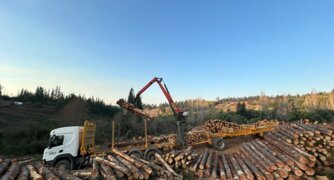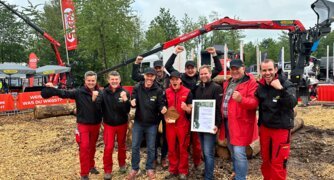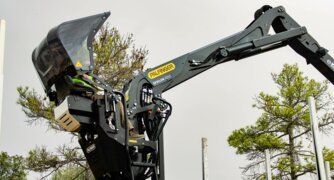L-CRANE OR Z-CRANE – THAT IS THE QUESTION...
L-CRANE – THE PERFORMER
The L-crane could be described as the mother of all timber cranes. This crane type has always traditionally been a firm favourite in Scandinavia and is characterised above all by its outstanding performance. The long main boom and short knuckle boom ensure the perfect working geometry, because the longer the main boom and the shorter the knuckle boom, the less the main boom has to be moved. This means that the crane operator does not have to spend as much time steering and controlling it and can focus instead on other tasks. Although the Z-crane is the most commonly used crane type in Central Europe, the L-crane has enjoyed increasing popularity in this region over the past few years. The L-crane is increasingly being deployed for railway loading tasks, for example. Once a day, the crane operator fetches a timber load from the forest, transports it to a large collection point and then spends the rest of the time loading it onto the train. This is why the L-crane is designed to be more pleasant to operate than the Z-crane, but other factors such as comfort and design also contribute to its optimal operating experience. The PALFINGER EPSILON M12L crane from the Next Epsolution series combines these attributes, helping operators to complete their tasks quickly and efficiently. With a reach of 9.7 metres, the 12-tonne-metre crane extends the working radius, which means that the crane operator does not constantly have to reposition the truck to be able to load the tree trunks.
Z-CRANE – THE TRANSFORMER
The Z-crane may not be the mother of all timber cranes, but it is the 'transformer' among cranes. Compared with the L-crane, the Z-crane is much more compact and so can be folded up transversely to the direction of motion. This means that the vehicle can be fully loaded up to the legally permissible total height, a factor that is particularly useful for work in sawmills. Once a tree trunk has been transported to the sawmill, it is unloaded. The Z-crane can be folded up and is not positioned on the loading area, which means that if the tree trunk is being unloaded by someone else, the crane operator does not have to leave the cab to reposition the crane. Most importantly, this ensures the safety of the crane operator because the wheel loader traffic in sawmills could result in accidents. PALFINGER has been building EPSILON Z-cranes for more than 25 years now, with the PALFINGER EPSILON M12Z commonly deployed for such tasks. The new design of the double-telescope system enables 900 mm more reach compared with the predecessor model, making it the biggest in the industry with its 10.5-metre reach.
Whether the L-crane or Z- crane, both crane types help operators to complete their tasks quickly and efficiently. Of course, which crane is the best for your company is entirely your decision, but you can always call upon the expert support of our PALFINGER authorised dealers, who will analyse your requirements together with you and help you to choose the right PALFINGER EPSILON crane for your needs.




